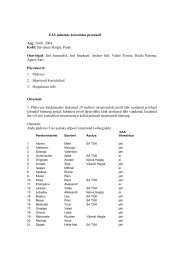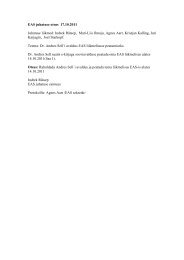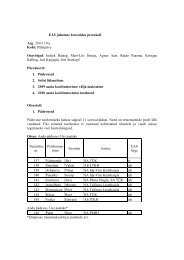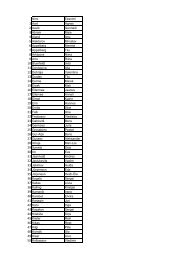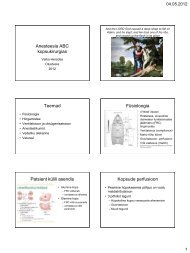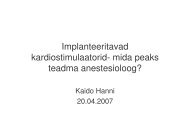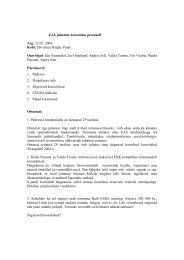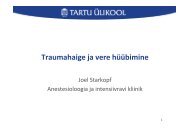The PiCCO system The PiCCO system
The PiCCO system The PiCCO system
The PiCCO system The PiCCO system
You also want an ePaper? Increase the reach of your titles
YUMPU automatically turns print PDFs into web optimized ePapers that Google loves.
HOW TO PRACTICALLY USE THE VARIOUS<br />
MONITORING SYSTEMS?<br />
<strong>The</strong> <strong>PiCCO</strong> <strong>system</strong><br />
Azriel Perel<br />
Professor and Chairman<br />
Department of Anesthesiology and Intensive Care<br />
Sheba Medical Center, Tel Aviv University<br />
Israel<br />
Rome 2009<br />
Disclosure<br />
<strong>The</strong> speaker cooperates with the following companies<br />
BMeye<br />
Drager-Siemens<br />
Pulsion<br />
perelao@shani.net<br />
1
<strong>The</strong> <strong>PiCCO</strong><br />
A multi-parametric<br />
approach to advanced<br />
hemodynamic<br />
monitoring<br />
<strong>The</strong> <strong>PiCCO</strong><br />
Central venous catheter<br />
<strong>The</strong>rmistor-tipped tipped<br />
arterial catheter<br />
• Femoral<br />
• Axillary<br />
• Brachial<br />
• Radial (long)<br />
{<br />
2
Clinical examination, vital signs, urine output, Hb, lactate...<br />
Preload &<br />
Fluid responsiveness<br />
EVLW<br />
Cardiac Output<br />
dP/dT, CFI, GEF, PVPI<br />
Preload &<br />
ScvO 2<br />
Clinical examination, vital signs, urine output, Hb, lactate...<br />
Preload &<br />
Fluid responsiveness<br />
EVLW<br />
Cardiac Output<br />
dP/dT, CFI, GEF, PVPI<br />
ScvO 2<br />
3
A man with fever and shortness of breath<br />
ScvO 2 72%<br />
CVP 9 mmHg<br />
Lactate 48<br />
PaO 2 /FiO 2 75 (PEEP 10)<br />
• CO 3.8<br />
• ITBVI<br />
950 (normaI)<br />
• EVLWI 15 (high)<br />
• SVR 1100<br />
Real-time CCO by the pulse contour method<br />
P [mm Hg]<br />
t [s]<br />
PCCO = cal • HR • ⌠ (<br />
P(t)<br />
+ C(p) •<br />
dP<br />
) dt<br />
⌡<br />
SVR<br />
dt<br />
Systole<br />
Arterial compliance and resistance are updated<br />
Patient-specific Heart Area of ComplianceShape of<br />
beat-to-beat calibration factor according rate<br />
pressure to a proprietary pressure algorithm<br />
(determined with<br />
curve<br />
curve<br />
that depends thermodilution) particularly on the arterial pressure<br />
and on dP/dt.<br />
4
Whole set of CI pairs<br />
Measurements recorded<br />
when SVR changed > 15%<br />
After a 1-hr calibration-free period, recalibration may be<br />
encouraged since it provides helpful information drawn<br />
from other thermodilution-derived variables.<br />
Clinical examination, vital signs, urine output, Hb, lactate...<br />
Preload &<br />
Fluid responsiveness<br />
EVLW<br />
Cardiac Output<br />
dP/dT, CFI, GEF, PVPI<br />
ScvO 2<br />
5
Clinical examination, vital signs, urine output, Hb, lactate...<br />
Preload &<br />
Fluid responsiveness<br />
EVLW<br />
Cardiac Output<br />
dP/dT, CFI, GEF, PVPI<br />
ScvO 2<br />
Intra-thoracic blood volume (ITBV)<br />
50<br />
c ICG<br />
[mg l -1 ]<br />
40<br />
30<br />
mtt cent<br />
70%<br />
ITBV = CO • mtt<br />
20<br />
33%<br />
10<br />
0<br />
0 10 20 30 40 50 60<br />
RAEDV RVEDV LAEDV LVEDV RAEDV RVEDV [s] PBV LAEDV LVEDV<br />
t<br />
GEDV<br />
ITBV<br />
6
Global End-Diastolic Volume as an Indicator of<br />
Cardiac Preload in Patients With Septic Shock<br />
F Michard et al, Chest. 2003;124:1900-1908<br />
800<br />
780<br />
760<br />
740<br />
720<br />
700<br />
680<br />
660<br />
640<br />
620<br />
600<br />
Pre-infusion<br />
GEDVi<br />
(mL/m 2 )<br />
Responders<br />
Non-responders<br />
% of fluid-responders<br />
ITBV and its changes correlates to CI and its changes<br />
significantly better than the CVP<br />
Crit Care Med 2008; 36: 2348<br />
7
Intravascular volume depletion in a 24-hour porcine model of<br />
intra-abdominal abdominal hypertension<br />
Schachtrupp A et al, J Trauma. 55: 734-740<br />
740, 2003<br />
Should we monitor preload and<br />
Should we monitor preload and<br />
fluid responsiveness in shock?<br />
8
Functional hemodynamic parameters<br />
(SPV, PPV, SVV) are the most sensitive<br />
parameters for the assessment of<br />
fluid responsiveness in mechanically<br />
ventilated patients<br />
SPV PPV SVV<br />
Clinical examination, vital signs, urine output, Hb, lactate...<br />
Preload &<br />
Fluid responsiveness<br />
EVLW<br />
Cardiac Output<br />
dP/dT, CFI, GEF, PVPI<br />
ScvO 2<br />
9
High EVLW content is<br />
associated with<br />
increased mortality<br />
(65-80% when EVLW>20 ml/kg)<br />
Sturm JA 1990<br />
Sakka S et al<br />
Chest 2002; 1232:2080-6<br />
N=373<br />
Mortality (%)<br />
90<br />
80<br />
70<br />
60<br />
50<br />
40<br />
30<br />
20<br />
EVLWI and Mortality<br />
(Highest measurement)<br />
Beale R 2001<br />
2_6 6_8 8_10 10_12 12_16 16_20 >20<br />
EVLWI (ml/kg)<br />
N=241<br />
FT Chung et al , respiratory Medicine 2008<br />
10
EVLW was markedly elevated (13.5 ml/kg) in patients<br />
with early ARDS, was significantly higher in nonsurvivors<br />
and correlated with Vd/Vt.<br />
<strong>PiCCO</strong> (ml/kg)<br />
EVLW-<br />
40<br />
30<br />
20<br />
10<br />
R 2 = 0.9758<br />
0<br />
0 10 20 30 40<br />
EVLW-grav. (ml/kg)<br />
• 15 dogs; EVLW<br />
measured by <strong>PiCCO</strong><br />
and, following sacrifice,<br />
by gravimetrics.<br />
• Control (n=5)<br />
• Non-cardiogenic<br />
pulmonary edema (oleic<br />
acid) (n=5)<br />
• Cardiogenic<br />
pulmonary edema (lt.<br />
atrial balloon) (n=5)<br />
11
A 63 yrs old patient with pulmonary edema after TURT<br />
24 hours later<br />
20 ml/kg 10 ml/kg<br />
Severe respiratory failure in a 33 yrs old patient following<br />
ruptured hematoma of the liver and multiple transfusions<br />
EVLW is only 5 ml/kg<br />
12
A patient with head injury, severe ARDS and septic shock<br />
BP<br />
HR<br />
CVP<br />
70/40 mmHg<br />
155 bpm<br />
5 cmH 2 O<br />
PaO 2 /FiO 2 80 (PEEP 16)<br />
Noradrenaline Would you give + fluids aggressive to this patient? diuresis!<br />
‣ CO<br />
= 12-1515 L/min<br />
‣ SVR = 400-500<br />
‣ ITBVI = 1200 ml/m 2 (800-1000)<br />
‣ EVLW = 19-23 ml/kg (4-7)<br />
High !!!<br />
Low !!!<br />
High !!!<br />
High !!!<br />
An old patient with chronic heart<br />
failure, sepsis, severe respiratory<br />
failure and hemodynamic<br />
instability.<br />
CO<br />
1.8 l/min<br />
LOW<br />
ITBVi<br />
EVLWi<br />
600 ml/m 2 LOW<br />
15 ml/kg HIGH<br />
SVV 25-30%<br />
HIGH<br />
A classic therapeutic (heart vs. lungs) conflict<br />
13
Start fluid loading!<br />
17.5<br />
EVLW<br />
30<br />
Stop fluid loading!<br />
A 63 years old male patient; developed fulminant<br />
pulmonary edema 4 hours into a re-total hip<br />
replacement. Hypoxemia (SaO2
R<br />
E<br />
S<br />
U<br />
L<br />
T<br />
S<br />
Decision tree for hemodynamic / volumetric monitoring**<br />
CI (l/min/m 2 ) 3.0<br />
GEDI (ml/m 2 )<br />
or ITBI (ml/m 2 )<br />
ELWI (ml/kg)<br />
CI (l/m 2 ) 1.9<br />
ITBVI<br />
(ml/m 2 )<br />
850<br />
CO (L)<br />
850<br />
10 10 10 10<br />
Fluids cautiously +<br />
catecholamines<br />
V+ V+! Cat Cat V+ V+!<br />
V-<br />
Cat<br />
V-<br />
T<br />
GEDI (ml/m 2 ) >700 700-800 >700 700-800 >700 700-800<br />
700-800<br />
H 1.<br />
or ITBI (ml/m 2 ) >850 850-1000 >850 850-1000<br />
E<br />
>850 850-1000<br />
850-1000<br />
R T<br />
+<br />
2. Optimise toSVV (%) 30<br />
OK!<br />
SVV % 22<br />
779 Start fluid loading!<br />
ELWI (ml/kg)*<br />
(slowly responding)<br />
≤10 ≤10 ≤10 ≤10<br />
EVLW<br />
(ml/kg)<br />
V+= volume loading (! = cautiously) V-= volume contraction Cat = catecholamine / cardiovascular agents<br />
+<br />
SVV only applicable in ventilated patients without cardiac ythmia arrh<br />
23<br />
**without guarantee<br />
*not available in USA<br />
29<br />
R<br />
E<br />
S<br />
U<br />
L<br />
T<br />
S<br />
Decision tree for hemodynamic / volumetric monitoring**<br />
CI (l/min/m 2 ) 3.0<br />
GEDI (ml/m 2 )<br />
or ITBI (ml/m 2 )<br />
ELWI (ml/kg)<br />
CI (l/m 2 ) 3.75<br />
ITBVI<br />
(ml/m 2 ) !!!<br />
ELWI (ml/kg)*<br />
(slowly responding)<br />
850<br />
EVLW (H)<br />
850<br />
10 10 10 10<br />
Diuresis<br />
V+ V+! Cat Cat V+ V+!<br />
V-<br />
Cat<br />
V-<br />
Stop fluid<br />
loading!<br />
T<br />
GEDI (ml/m 2 ) >700 700-800 >700 700-800 >700 700-800<br />
700-800<br />
H 1.<br />
or ITBI (ml/m 2 ) >850 850-1000 >850 850-1000<br />
E 1444<br />
>850 850-1000<br />
850-1000<br />
R T<br />
+<br />
2. Optimise toSVV (%) 30<br />
OK!<br />
SVV % 15<br />
≤10 ≤10 ≤10 ≤10<br />
EVLW<br />
(ml/kg)<br />
V+= volume loading (! = cautiously) V-= volume contraction Cat = catecholamine / cardiovascular agents<br />
+<br />
SVV only applicable in ventilated patients without cardiac ythmia arrh<br />
**without guarantee<br />
15<br />
*not available in USA<br />
30<br />
15
This ‘flash’ permeability of uncertain<br />
etiology (TRALI?) was associated with<br />
severe hypovolemia and improved<br />
spontaneously even though fluids were<br />
liberally administered<br />
Table 2<br />
PACU<br />
Fluid loading<br />
Postop Day 1<br />
Postop Day 2<br />
CI (l/m 2 )<br />
1.9<br />
3.75<br />
2.89<br />
3.47<br />
ITBVI (ml/m 2 )<br />
779<br />
1444 !!!<br />
972<br />
1093<br />
SVV %<br />
22<br />
15<br />
EVLW<br />
(ml/kg)<br />
EVLW /<br />
ITBV<br />
23<br />
15<br />
1.82<br />
*PEF/plasma TP ratio=1<br />
*<br />
0.73<br />
8<br />
5<br />
0.36<br />
7<br />
4<br />
0.26<br />
Clinical examination, vital signs, urine output, Hb, lactate...<br />
Preload &<br />
Fluid responsiveness<br />
EVLW<br />
Cardiac Output<br />
dP/dT, CFI, GEF, PVPI<br />
ScvO 2<br />
16
34 yr female; Very severe respiratory failure;<br />
Hemodynamic collapse; on noradrenaline.<br />
BP<br />
113 / 67 mmHg<br />
CI<br />
2.7 l/min/m<br />
2<br />
HR<br />
91 bpm<br />
ITBVi 578 ml/m 2<br />
Urine<br />
Good<br />
SaO 2 86% !!!<br />
ScvO 2 80% !!!<br />
EVLWi 20 ml/kg<br />
ICG PDR 6.7%<br />
(LiMON) (18-25%)<br />
Have we achieved initial resuscitation goals<br />
in this patient?<br />
17
<strong>The</strong> PiCClin Study<br />
A Perel, M Maggiorini, M Malbrain, JL Teboul, J Belda,<br />
E Fernández-Mondéjar, M Kirov, J Wendon<br />
<strong>The</strong> patient population included 206 patients,<br />
which were evaluated by 166 residents and 146<br />
specialists (total of 315 questionnaires).<br />
Participants i t were asked to predict advanced<br />
d<br />
hemodynamic parameters and decide on a<br />
therapeutic plan prior to <strong>PiCCO</strong> insertion.<br />
<strong>The</strong> PiCClin Study<br />
A Perel, M Maggiorini, M Malbrain, JL Teboul, J Belda,<br />
E Fernández-Mondéjar, M Kirov, J Wendon<br />
<strong>The</strong> main reasons for using the <strong>PiCCO</strong><br />
monitoring <strong>system</strong> included:<br />
‣ Unclear fluid status (136)<br />
‣ Suspected sepsis / septic shock (89)<br />
‣ Respiratory failure (59)<br />
‣ Cardiogenic shock (24)<br />
‣ Renal failure (32)<br />
‣ Other (21)<br />
18
<strong>The</strong> accuracy of predicted cardiopulmonary parameters<br />
CO<br />
(n=315)<br />
SVR<br />
(n=312)<br />
GEDVi<br />
(n=314)<br />
EVLWi<br />
(n=304)<br />
Underestimation<br />
>20%<br />
170<br />
(54%)<br />
46<br />
(14.7%)<br />
97<br />
(30.9%)<br />
83<br />
(27.3%)<br />
Within ± 20%<br />
110<br />
(34.9%)<br />
107<br />
(34.3%)<br />
154<br />
(49%)<br />
124<br />
(40.8%)<br />
Overestimation<br />
>20%<br />
35<br />
(11.1%)<br />
159<br />
(51%)<br />
63<br />
(20.1%)<br />
97<br />
(31.9%)<br />
<strong>The</strong> PiCClin Study<br />
<strong>The</strong> PiCClin Study<br />
II: Change of therapeutic plan following advanced<br />
rdiopulmonary monitoring in critically ill patients<br />
In the absence of further hemodynamic<br />
information, what would be your<br />
therapeutic decision?<br />
Fluid<br />
loading<br />
Red blood<br />
cells<br />
Inotropic<br />
agent<br />
Vasoconstrictor<br />
Diuretic<br />
Dialysis/<br />
filtration<br />
Other<br />
19
<strong>The</strong> PiCClin Study<br />
II: Change of therapeutic plan following advanced<br />
rdiopulmonary monitoring in critically ill patients.<br />
Original therapeutic plan<br />
Fluids<br />
(n=315)<br />
Pursued<br />
67.6%<br />
Changed<br />
32.4%<br />
Inotropes<br />
78.4%<br />
21.6%<br />
Vasoconstrictors<br />
Diuretics<br />
77.5%<br />
86.1%<br />
22.5%<br />
13.9%<br />
Forty-six patients with SAH treated within 24 hours of the<br />
ictus were investigated.<br />
A fluid management protocol emphasizing supplemental<br />
colloid administration was used to attain the following<br />
targets:<br />
‣ CI - 3.0 L/min/m 2<br />
‣ GEDVi - 700-900 mL/m 2<br />
‣ EVLW < 14 mL/kg<br />
20
Initially the CI was high (5.3<br />
L/min/m 2 ) and the GEDVi low (555<br />
mL/m 2 ), with elevations of plasma<br />
adrenaline, noradrenaline, and<br />
cortisol.<br />
CI progressively decreased and<br />
GEDVi was normalized by fluid<br />
administration aimed at<br />
normovolemia.<br />
Mutoh et al<br />
21
Guiding therapy by<br />
an algorithm based<br />
on GEDVI leads to a<br />
shortened and<br />
reduced need for<br />
vaso-pressors,<br />
catecholamines,<br />
mechanical<br />
ventilation,<br />
and ICU therapy in<br />
patients undergoing<br />
cardiac surgery.<br />
Norepinephrine<br />
Epinephrine<br />
Goepfert et al, ICM 2007<br />
<strong>The</strong> use of <strong>PiCCO</strong> resulted in:<br />
1. Early recognition of<br />
hypovolemia and<br />
myocardial depression.<br />
2. Better titration of fluid and<br />
inotrope / vasopressor<br />
therapy.<br />
3. Shorter hospital length of<br />
stay after OPCAB.<br />
22
Targeting EVLW in ARDS<br />
n=101<br />
22 days<br />
* *<br />
15 days<br />
9 days<br />
7 days<br />
RHC group<br />
EVLW group<br />
RHC group<br />
EVLW group<br />
Ventilation days<br />
ICU days<br />
After: Mitchell et al, Am Rev Resp Dis 145: 990-998, 1992<br />
When EVLW is high<br />
C. Philips et al<br />
23
“This protocol allows aggressive diuresis of<br />
excess preload even during periods of shock –<br />
something not done in the FACTT trial and<br />
rarely done clinically. This is accomplished by<br />
better identifying preload state using superior<br />
metrics of preload and cardiovascular status –<br />
GEDI, CI, and EVLW.” C. Philips (with permission)<br />
How should the <strong>PiCCO</strong> be used?<br />
1. Is there a problem?<br />
2. Identify the problem(s)<br />
3. Which seems to be the most critical problem?<br />
4. Is there a therapeutic conflict?<br />
5. Out of your potential therapeutic options, which<br />
decision will cause most/least damage in case of<br />
error?<br />
6. Make your decision and follow results<br />
7. Go back to (1)<br />
24
When do I use the <strong>PiCCO</strong>?<br />
‣ CHF + major surgery<br />
‣ Sepsis<br />
‣ ARDS, MOF<br />
‣ Pulmonary edema<br />
‣ <strong>The</strong>rapeutic conflicts<br />
‣ Expected hemodynamic instability<br />
‣ When the patient cannot afford to pay<br />
the price of my mistake<br />
Conclusion<br />
‣ Critically ill patients do often have complex<br />
hemodynamics and may often present us with<br />
heart-lung and other therapeutic conflicts.<br />
‣ Since all individual hemodynamic<br />
parameters have limitations and confounding<br />
factors, a multi-parametric hemodynamic<br />
approach that includes EVLW reduces the<br />
chance of erroneous critical decisions.<br />
25
Clinical examination, vital signs, urine output, Hb, lactate...<br />
Preload &<br />
Fluid responsiveness<br />
EVLW<br />
Cardiac Output<br />
dP/dT, CFI, GEF, PVPI<br />
Thank you!<br />
ScvO 2<br />
26
Cardiac output 6.77 L/min<br />
ScvO 2 is 60%!<br />
Is this CO adequate?<br />
Patient is given dobutamine<br />
CO<br />
ScvO 2 =63<br />
ScvO 2 =74<br />
ScvO 2 =76<br />
CO was high, but not high enough!<br />
<strong>The</strong> CO and the ScvO 2 complement each other!<br />
27




